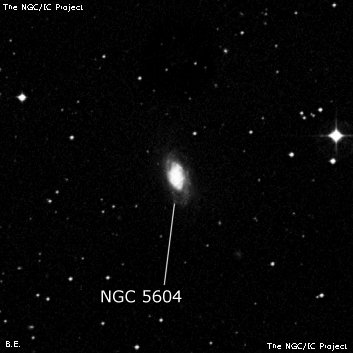
William Herschel discovered NGC 5604 = H III-668 = h1799 on 15 Apr 1787 (sweep 730) and recorded "cF, S, r." His RA is 7 tsec too large. On 15 Apr 1828 (sweep 146), John Herschel called it "F; pL; vgbM to a stellar point." and measured an accurate position.
400/500mm - 17.5" (6/8/91): fairly faint, small, elongated 3:2 N-S, broadly concentrated with no defined nucleus. A mag 10.5 star is 4.7' WNW.
900/1200mm - 48" (4/19/17): at 488x; fairly bright, moderately large, oval 4:3 or 3:2 ~N-S, ~50"x35" . Contains a bright, elongated, mottled core. The N-S extensions are a bit non-symmetric in surface brightness with a hint of spiral structure, but nothing definite.
VIII Zw 414, a very close pair, lies 10' NE. At 610x, the brighter western component appeared moderately bright, small, round, 15" diameter, fairly high surface brightness. Forms a very close pair with edge-on FGC 1750 just 12" E! A wide bright double (9.2/11.1 at 18") lies 2.5' N. FGC 1750 was logged as faint to fairly faint, very small, round, 6" diameter [this is the nucleus of the galaxy]. It occasionally elongated with extremely faint wings SW and NE increasing the size to 25"x6".
Notes by Steve Gottlieb